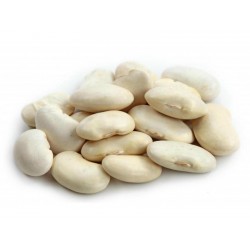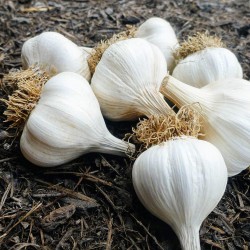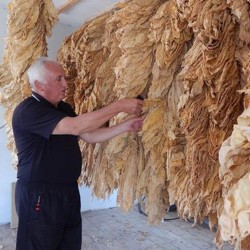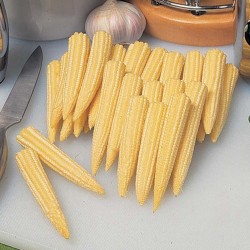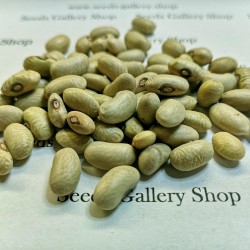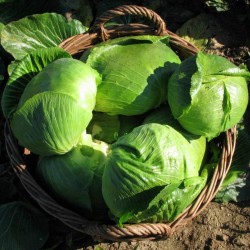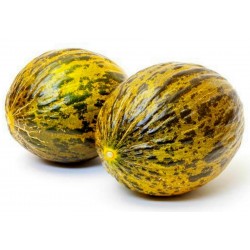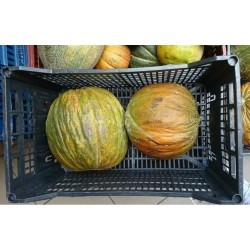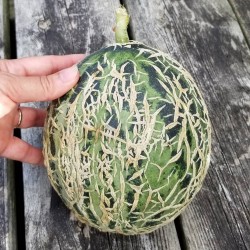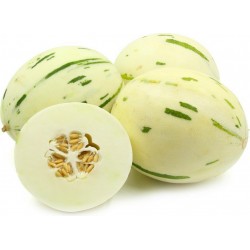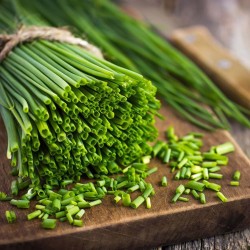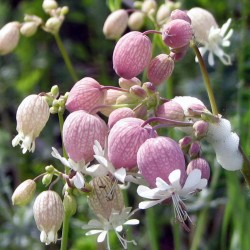Seeds Gallery Com,
5/
5
<meta http-equiv="Content-Type" content="text/html; charset=UTF-8" />
<div id="idTab1" class="rte">
<h2><strong>SNOW LEOPARD Melon Seeds - VERY RARE</strong></h2>
<h2><span style="color: #ff0000;"><strong>Price for Package of 5 or 10 seeds.</strong></span></h2>
<p>Snow Leopard melon, very rare, exotic, sweet, delicious, beautiful, unique ...</p>
<p><strong>OTHER NAMES: IVORY GAYA MELON, SILVER STAR (SEREBRYANAYA ZVEZDA)...</strong></p>
<p><span>The Ivory Gaya melon has a unique variegated exterior, as the name suggests the base color of the skin is an ivory cream covered in small lime green speckles and streaks. A petite melon the Ivory Gaya has an oblong shape. Ivory Gaya melons have a thin outer rind, that when cut reveals a creamy white inner flesh. Toward the center of the melon the flesh is soft and juicy, the flesh closer to the skin of the Ivory Gaya melon will have a crisper texture. The Ivory Gaya offers a sweet flavor, with nuances of pear and honey. When ripe its blossom end will have a slight give and when at room temperature will offer a sweet and rich melon aroma. </span></p>
<p><strong>Seasons/Availability</strong></p>
<p><span>Ivory Gaya melons are available in the late spring and early summer months. </span></p>
<p><strong>Current Facts</strong></p>
<span>A member of the Cucurbitaceae or Cucurbit family the Ivory Gaya melon is of the muskmelon species and botanically known as Cucumis melo inodorus ‘Ivory Gaya’. Also known as the Snow Leopard melon the Ivory Gaya is often referred to as an "ice box" variety melon as a result of its petite size that easily fits in a crisper drawer. This honeydew cultivator is a specialty melon and sought after for its unique exterior coloring and sweet melon flavor. </span><br />
<p><strong>Applications</strong></p>
<span>Like many honeydew cultivator melons the Ivory Gaya has an exceptionally sweet flavored flesh that is ideal for fresh eating. Its petite size makes it perfect as a personal melon which can be halved and eaten as is for one. Pureed it can be used as a base for cold soups or sauces. Cubed it can be added to both fruit and green salads or used on fruit kebabs. Companion flavors include salty Italian meats such as salami and prosciutto, parmesan cheese, feta, balsamic vinegar, berries, grapes, tomato, olives and lime juice. Keep at room temperature until ripe. Uncut melons can be kept in the refrigerator for up to five days. Once sliced melon will keep best wrapped in plastic in the refrigerator and when used within three days. </span><br />
<p><strong>Geography/History</strong></p>
<span>The Ivory Gaya melon is native to Japan. In addition to Japan, today it can be found growing in China, Mexico, South America and in North America, specifically in southern California. A vining type the Ivory Gaya melon thrives in warm sunny conditions. Sill a rather unique variety melon in California the Ivory Gaya can be found at select Asian markets, farmers markets and specialty grocers. </span><br />
<div>
<div id="restaurantSlide"></div>
</div>
<p>Melons: <em>Cucumis melo</em><br />Watermelons: <em>Citrullus lanatus</em><br /><br />The sweet succulence of summer-ripe melons is irresistibly tempting, but the health benefits of these luscious fruits shouldn't be overlooked. Look to red-fleshed melons to fortify the heart and urinary tract. Yellow and orange flesh types provide support to the immune system, heart and vision. Green-fleshed varieties promote strong bones and teeth as well as vision health. We've selected varieties that are successful in both southern and northern gardens.<br /><br /><strong>CULTURE:</strong> All types of melons can be direct sown in warmer regions, but will yield a much better crop if started indoors about 3 weeks prior to your last frost. We recommend planting in raised beds covered with green, silver, or black plastic mulch. This method produces better yields.</p>
<p><br /><strong>FOR TRANSPLANTS:</strong></p>
<p>Fill 3-4 inch, individual pots with sterile seedling mix. Plant 2-3 seeds per pot. Thin the pots to the best single plant after the seedlings are well established. Grow the seedlings under dry, warm conditions until they develop at least 1 true leaf. Transfer to cold frame if you have one. Fertilize seedlings with a fertilizer such as 2-1-1 Earth Juice Grow (ZFE245). Transplant into the garden just before the plants become root bound and when the soil temperature is at least 60°F. Space transplants 3-4 feet apart in rows 5-6 feet apart. Apply 1/2 cup of our complete fertilizer dug in well around each plant.</p>
<p><br /><strong>TO DIRECT SOW:</strong></p>
<p>Soil temperature must be above 70°F for decent germination. Like most vine crops, melon and watermelon seeds require even moisture levels to prevent rotting. The soil should be moist to the touch. Space and fertilize as you would transplants. Watermelon seeds are less tolerant of cool conditions than cantaloupe. They are best adapted to the warmer, longer season areas of the US. In more difficult climates, the use of plastic mulch is highly recommended. Plastic mulches increase the soil temperature and air temperature close to the plants during the day, and using a floating row cover like Reemay or Gro-Therm can also increase your success. Monitor the temperature under the row covers on hot days especially early in the season.</p>
<p><br /><strong>DISEASES:</strong></p>
<p>Select disease-resistant melon varieties, as bacterial wilt and powdery mildew are common problems. Watermelons are subject to several wilts, and fungal and viral diseases. Most can be controlled with good soil management, proper rotation, garden sanitation, and by not using overhead watering methods.</p>
<p><br /><strong>INSECTS/PESTS:</strong></p>
<p>Control insects, especially cucumber beetles, with Pyrethrin or a floating row cover.</p>
<p><br /><strong>HARVEST:</strong></p>
<p>Cantaloupe will easily slip from the vine when ripe. With other melons, check the leaf where the fruit is attached to the vine. The fruit is mature when this leaf begins to yellow. Watermelons are ready for harvest when the tendril closest to the fruit is dry and brown or when the bottom side of the fruit is yellow. Melons and watermelons will not ripen off the vine. Pick in the cool of the day and chill quickly. Store melons at 35°F and 95% relative humidity. Store watermelons at 45°F and 85% relative humidity.</p>
<p><br /><strong>SEED SPECS:</strong></p>
<p>Minimum germination standard: 80%. Usual seed life: 3 years. Days to maturity: from date of transplanting. Add 10-15 days if direct seeding.</p>
</div>
V 165 (5 S)


